Hello again everyone here is Part Two of Three for my Nigiri Sushi Article. In this part, I will introduce more Fish Nigiri Sushi that you may only find in Sushi Bars or only in Japan. The Nigiri Sushi that only can be found in Japan is due to that you only can find that particular fish only in Japan or during a certain seasons, which I will also list. I have not listed the prices on these nigiri sushi due to each Sushi Bar may vary, but they may vary about 400 to 2000 yen.
So Lets begin with our list of Fish Nigiri Sushi:
-
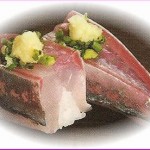 Aji (Japanese Horse Mackerel)*: This is a fresh Aji, which is cut into bite size and placed on top of the sushi rice. It’s topped with chopped green onions and fine graded with ginger. The season for Aji is in the months of May ~ September.
Aji (Japanese Horse Mackerel)*: This is a fresh Aji, which is cut into bite size and placed on top of the sushi rice. It’s topped with chopped green onions and fine graded with ginger. The season for Aji is in the months of May ~ September.
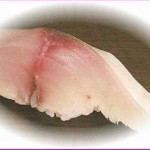 Shimesaba (Chub Mackerel)*: This is a Shimesaba soaked with vinegar and salt, is cut into bite size and placed on top of the sushi rice. The season for the Shimesaba is in the months of September ~ January.
Shimesaba (Chub Mackerel)*: This is a Shimesaba soaked with vinegar and salt, is cut into bite size and placed on top of the sushi rice. The season for the Shimesaba is in the months of September ~ January.
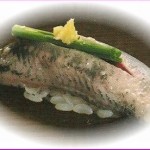 Iwashi (Japanese Pilchard)*: This is a fresh Iwashi, which is cut into a long bite size and placed on top of the sushi rice. It’s topped with long cuts of green onions and fine graded with ginger. The season for Iwashi is in the months of May ~ November.
Iwashi (Japanese Pilchard)*: This is a fresh Iwashi, which is cut into a long bite size and placed on top of the sushi rice. It’s topped with long cuts of green onions and fine graded with ginger. The season for Iwashi is in the months of May ~ November.
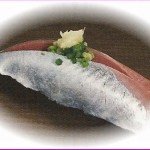 Sanma (Pacific Saury)*: This is a fresh Sanma, which is cut into a thin long bite size slice and placed on to of the sushi rice. It’s topped with chopped green onions and fine graded with ginger. The season for the Sanma is in the months of September ~ November.
Sanma (Pacific Saury)*: This is a fresh Sanma, which is cut into a thin long bite size slice and placed on to of the sushi rice. It’s topped with chopped green onions and fine graded with ginger. The season for the Sanma is in the months of September ~ November.
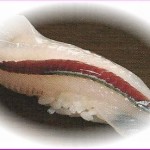 Sayori (Japanese Half beak)*: This is a fresh Sayori, which is cut into a small thin long bite size slice and placed on top of the sushi rice. The season for the Sayori is in the months of March ~ May.
Sayori (Japanese Half beak)*: This is a fresh Sayori, which is cut into a small thin long bite size slice and placed on top of the sushi rice. The season for the Sayori is in the months of March ~ May.
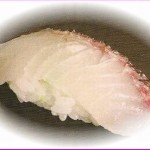 Madai (Red Sea Bream)*: This is a fresh Madai, which is cut into a small thin long bite size slice and placed on top of the sushi rice. The season for the Madai is in the months of November ~ May.
Madai (Red Sea Bream)*: This is a fresh Madai, which is cut into a small thin long bite size slice and placed on top of the sushi rice. The season for the Madai is in the months of November ~ May.
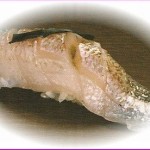 Kisu (Japanese Sillago)*: This is a fresh Kisu, which is cut into a small thin bite size slice and placed on top of the sushi rice. The season for the Kisu is in the months of June ~ August.
Kisu (Japanese Sillago)*: This is a fresh Kisu, which is cut into a small thin bite size slice and placed on top of the sushi rice. The season for the Kisu is in the months of June ~ August.
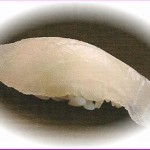 Suzuki (Japanese Sea Perch)*: This is a fresh Suzuki, which is cut into a small long thin bite size slice and placed on top of the sushi rice. The season for the Suzuki is in the months of June ~ August.
Suzuki (Japanese Sea Perch)*: This is a fresh Suzuki, which is cut into a small long thin bite size slice and placed on top of the sushi rice. The season for the Suzuki is in the months of June ~ August.
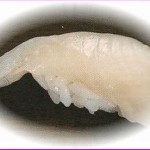 Ainame (Fat Greenlig)*: This is a fresh Ainame, which is cut into a long thin bite size slice and placed on top of the sushi rice. The season for the Ainame is in the months of March ~ May.
Ainame (Fat Greenlig)*: This is a fresh Ainame, which is cut into a long thin bite size slice and placed on top of the sushi rice. The season for the Ainame is in the months of March ~ May.
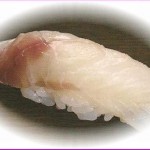 Hohboh (Red Gurnard)*: This is a fresh Hohboh, which is cut into a long thin bite size slice and placed on top of the sushi rice. The season for the Hohboh is in the month of December ~ February.
Hohboh (Red Gurnard)*: This is a fresh Hohboh, which is cut into a long thin bite size slice and placed on top of the sushi rice. The season for the Hohboh is in the month of December ~ February.
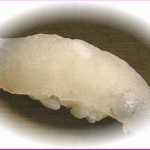 Magochi (Bartail Flathead)*: This is a fresh Magochi, which is cut into a long thin bite size slice and placed on top of the sushi rice. The season for the Magochi is in the months of June ~ August.
Magochi (Bartail Flathead)*: This is a fresh Magochi, which is cut into a long thin bite size slice and placed on top of the sushi rice. The season for the Magochi is in the months of June ~ August.
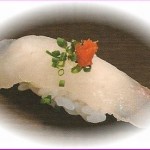 Okoze ((Devil Stinger)*: This is a fresh Okoze, which is cut into a long thin bite size slice and placed on top of the sushi rice. It is topped with chopped green onions and graded red ginger. The season for the Okoze is in the months of June ~ August.
Okoze ((Devil Stinger)*: This is a fresh Okoze, which is cut into a long thin bite size slice and placed on top of the sushi rice. It is topped with chopped green onions and graded red ginger. The season for the Okoze is in the months of June ~ August.
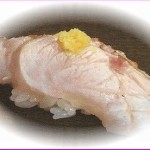 Nodoguro (Blackthroat Sea Perch)*: This is a fresh Nodoguro, which is cut into a long thin bite size slice and placed on top of the sushi rice. It is topped with grated ginger. The season for the Nodoguro is in the months of December ~ February.
Nodoguro (Blackthroat Sea Perch)*: This is a fresh Nodoguro, which is cut into a long thin bite size slice and placed on top of the sushi rice. It is topped with grated ginger. The season for the Nodoguro is in the months of December ~ February.
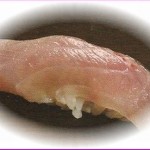 Mutsu (Gnomefish)*: This is a fresh Mutsu, which is cut into long thin bite size slice and placed on top of the sushi rice. The season for the Mutsu is in the months of December ~ February.
Mutsu (Gnomefish)*: This is a fresh Mutsu, which is cut into long thin bite size slice and placed on top of the sushi rice. The season for the Mutsu is in the months of December ~ February.
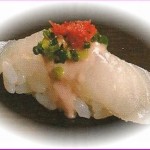 Kawahagi (Threadsail Filefish)*: This is a fresh Kawahagi, which is cut into a long thin bite size slice and placed on top of the sushi rice. It is topped with chopped green onions, red chill, and fine graded radish. The season for the Kawahagi is in the months of June ~ December.
Kawahagi (Threadsail Filefish)*: This is a fresh Kawahagi, which is cut into a long thin bite size slice and placed on top of the sushi rice. It is topped with chopped green onions, red chill, and fine graded radish. The season for the Kawahagi is in the months of June ~ December.
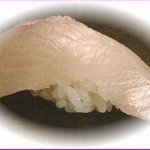 Kanpachi (Greater Amber-jack)*: This is a fresh Kanpachi, which is cut into a long thin bite size slice and place on top of the sushi rice. The season for the Kanpachi is in the months of June ~ August.
Kanpachi (Greater Amber-jack)*: This is a fresh Kanpachi, which is cut into a long thin bite size slice and place on top of the sushi rice. The season for the Kanpachi is in the months of June ~ August.
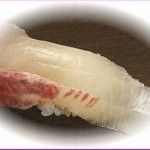 Hiramasa (Yellow-tail Amber jack)*: This is a fresh Hiramasa, which is cut into a long thin bite size slice and placed on the top of the sushi rice. The season for the Hiramasa is in the months of June ~ August.
Hiramasa (Yellow-tail Amber jack)*: This is a fresh Hiramasa, which is cut into a long thin bite size slice and placed on the top of the sushi rice. The season for the Hiramasa is in the months of June ~ August.
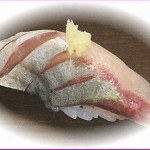 Shima-Aji (White trevally)*: This is a fresh Shima-Ajisoaked with vinegar and salt, is cut into a long thin bite size slice and place on top of the sushi rice. It is topped with fine graded ginger. The season for the Shima-Aji is in the months of June ~ August.
Shima-Aji (White trevally)*: This is a fresh Shima-Ajisoaked with vinegar and salt, is cut into a long thin bite size slice and place on top of the sushi rice. It is topped with fine graded ginger. The season for the Shima-Aji is in the months of June ~ August.
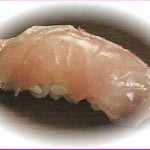 Kinmeda (Alfonsino)*: This is a fresh Kinmeda, which is cut into a thin bite size slice and placed on top of the sushi rice. The season for the Kinmeda is in the months of December ~ February.
Kinmeda (Alfonsino)*: This is a fresh Kinmeda, which is cut into a thin bite size slice and placed on top of the sushi rice. The season for the Kinmeda is in the months of December ~ February.
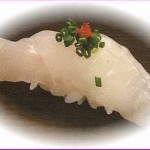 Hata (Convict Grouper)*: This is a fresh Hata, which is cut into a long thin bite size slice and place on top of the sushi rice. It is topped with chopped green onions and fine grated red chill. The season for the Hata is in the months of June ~ August.
Hata (Convict Grouper)*: This is a fresh Hata, which is cut into a long thin bite size slice and place on top of the sushi rice. It is topped with chopped green onions and fine grated red chill. The season for the Hata is in the months of June ~ August.
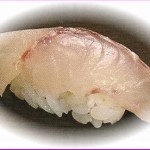 Isaki (Chicken Grunt)*: This is a fresh Isaki, which is cut into a long thin bite size slice and placed on top of the sushi rice. The season for the Isaki is in the months of June ~ August.
Isaki (Chicken Grunt)*: This is a fresh Isaki, which is cut into a long thin bite size slice and placed on top of the sushi rice. The season for the Isaki is in the months of June ~ August.
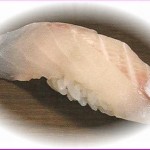 Ishida (Barred Knife-jaw)*: This is a fresh Ishida, which is cut into a long thin bite size slice and placed on top of the sushi rice. The season of the Ishida is in the months of June ~ August.
Ishida (Barred Knife-jaw)*: This is a fresh Ishida, which is cut into a long thin bite size slice and placed on top of the sushi rice. The season of the Ishida is in the months of June ~ August.
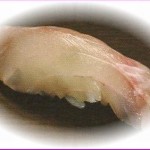 Mejina (Large-scale Black fish)*: This is a fresh Mejina, which is cut into a long thin bite size slice and placed on top of the sushi rice. The season of the Mejina is in the months of December ~ February.
Mejina (Large-scale Black fish)*: This is a fresh Mejina, which is cut into a long thin bite size slice and placed on top of the sushi rice. The season of the Mejina is in the months of December ~ February.
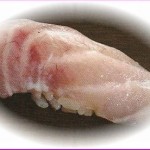 Mebaru (Dark-banded Rock fish)*: This is a fresh Mebaru, which is cut into a long thin bite size and placed on top of the sushi rice. The season of the Mebaru is in the months of March ~ May.
Mebaru (Dark-banded Rock fish)*: This is a fresh Mebaru, which is cut into a long thin bite size and placed on top of the sushi rice. The season of the Mebaru is in the months of March ~ May.
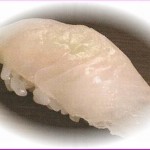 Hirame (Bastard Halibut)*: This is a fresh Hirame, which is cut into a long thin bite size slice and placed on top of the sushi rice. The season for the Hirame is in the months of September ~ February.
Hirame (Bastard Halibut)*: This is a fresh Hirame, which is cut into a long thin bite size slice and placed on top of the sushi rice. The season for the Hirame is in the months of September ~ February.
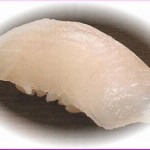 Makogarei (Marbled Flounder)*: This is a fresh Makogarei, which is cut into a long bite size slice and placed on top of the sushi rice. The season for the Makogarei is in the months of June ~ August.
Makogarei (Marbled Flounder)*: This is a fresh Makogarei, which is cut into a long bite size slice and placed on top of the sushi rice. The season for the Makogarei is in the months of June ~ August.
Here is a special type of Nigiri Sushi which require by law to have a licence to make, due to the poison which this fish. It is call “Fugu” or Japanese puffer fish. This is one of my favorite Nigiri Sushi, this can be very expensive in most Sushi places in Japan. I have seen this in Hawaii in our last trip last year, but I didn’t try it. I wasn’t sure if it was Fugu or a different fish, I don’t think you can get the same fish from Japan. It more likely I didn’t trust the restaurant, I think.
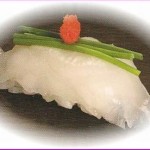 Fugu (Japanese Puffer fish)*: This a fresh Fugu, that is cut into long thin bite size slice and placed on top of the sushi rice. The season for the Fugu is in the months of December ~ February.
Fugu (Japanese Puffer fish)*: This a fresh Fugu, that is cut into long thin bite size slice and placed on top of the sushi rice. The season for the Fugu is in the months of December ~ February.
Theres the list of other Fish type Nigiri Sushi. In the final part of my Nigiri Report, I will list the other seafood that are not fish. That list you may find in your country, from what I have seen. I hope that you enjoy reading this part two of three, “Nigiri Sushi” article I hope that you will be back for part 3. Have a great day.
*Note: Mostly all of the Nigiri Sushi I have list comes with wasabi(horse radish), in between the fish and the sushi rice.

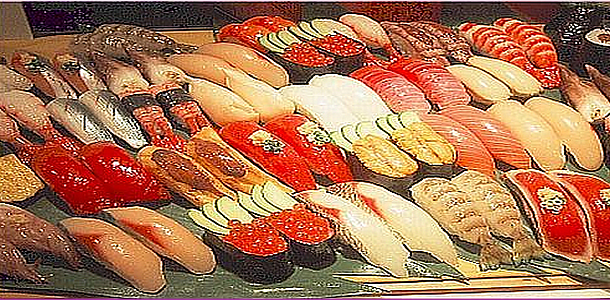
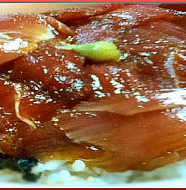
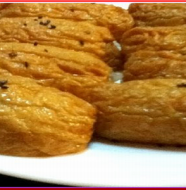
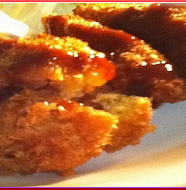












Yammy sushi fish, I love it, although doctors don’t recommend eat it, due to microorganisms from it.
I am in loved with Japanese cuisine, especially in sushi made from Japanese sea perch and fat greenlig with good sauce it’s delicious.
It is great when in Japanese restaurants different types of sushi are served on the same plate, and you can taste them all.
Although Nigiri sushi is commonly called two kinds sushi I love it, it is simple and tastes amazing.
Yammmy, I wonder who was the first man to eat sushi, who is the inventor, he should receive Nobel Prize.
Dear Naoko, your Nigiri sushi options look great, but could you provide us with some information on Makizushi.
A few months ago I went to a sushi bar, and the Nigiri sushi I got was bigger then an usual sushi, unfortunately they didn’t gave me a knife and it was problematic eating it.
Could someone give me an advice what type of rice should I use in preparing sushi.
I wonder is there any recipe of making Nigiri Sushi using some caviar, beside rice, cause I’m a bit tired of the old fashion recipe.
From my own experience I can tell that eating rice below the Nigiri would not give you a yummy taste. So before eating Nigiri make it sure that you know what is the right way of eating because sushi chefs chiefly give importance to the fish.
Recently a sushi bar near my home was closed by an inspection they’ve found some organisms in fish, so I guess it’s not healthy to eat sushi.
I love sushi. Just can `t live without them. I especially like uramaki and nigiri. I read a lot of interesting about the useful properties of sushi.
I love Japanese food, especially sushi .. so hungry saw your article ..
Nigiri sushi puts everything in full sight for you: It’s your selected protein on rice with a touch of wasabi between the two. The raw fish on top of the rice is called sashimi and can be ordered without the rice on the bottom as an appetizer. This is not the kind of sushi wrapped in seaweed; nigiri sushi is just fish, egg or tofu on rice.
Nigiri Sushi is one of the classic Sushi styles. The basic for this Sushi is the sushi rice that is formed by hand into small oval rice balls. This rice ball is topped with some thin slices of fish. I wonder how much expertise is needed to prepare something more complicated.
Is it true that one of the greatest delicacies in the sushi case is ama ebi, when cleaned, is shiny, almost transparent, and sweet.
I’ve heard that Nigiri requires using big shrimps. Usually shrimps come in a frozen bag, raw or boiled. Raw shrimps are covered in greenish shell and boiled shrimps are white with red spine.
Nigiri Sushi is refined , with a funky bite to its elegance. Modern with Japanese flair, Fusion and filled with exceptional art.
It is not so difficult to make a nigiri-zushi by hand-forming for the beginners, but also is said that it requires a few years to master the way duly, which can be pretty hard for a beginner.
I am often amazed at the way sushi has spread across the world, and delighted that Westerners have come to love this healthy dish. However, I have to admit that I’m a little dismayed at some of the strange ingredients that are sometimes included, and the odd places it turns up. The sushi you find in refrigerated displays at your local grocery bears little resemblance to the real thing.
I am in loved with Japanese cuisine , especially in sushi made from Japanese sea perch and fat greenlig with good sauce it’s delicious.
Recently I found this recipe: “Make a paste out of mustard, water, and shoyu. Shape sushi rice into oblongs about 1″ x 2 1/2″; flatten slightly. Pat mustard paste on rice; press desired topping on top. Dip in shoyu to eat.”
Different toppings I’ve tried and liked: tamago, crabstick, spam, unagi, salmon, and tuna. If you include nigiri using raw fish in your bento, be sure to refrigerate so that the fish doesn’t spoil. Just take the sushi out of the fridge about half an hour prior to eating so that everything can warm up to room temperature (and the rice can soften as it often hardens when refrigerated).
Oshinko assorted pickled vegetables, which can be very salty. Another term for pickled vegetables is tsukemono. Depending on the restaurant, the latter can refer to a pickled cucumber salad. The vegetables generally include pickled carrot, cucumber, eggplant and different types of radish.
Not bad for all you can eat sushi! Some of the dishes actually come out in really creative ways like with lots of leafy decorations and/or sauces squirted in artistic patterns.
Just recently I found out that sushi does not mean raw seafood; instead, it refers to the vinegared rice that can be paired with raw seafood. So even vegetarians and those determined on having their meals cooked can be satisfied by sushi.
Recently I came to the conclusion that I’ll have to spend all my life tasting all those millions of types of sushi.
It is not so difficult to make a nigiri-zushi by hand-forming for the beginners, but also is said that it requires a few years to master the way duly, which can be pretty hard for a beginner.